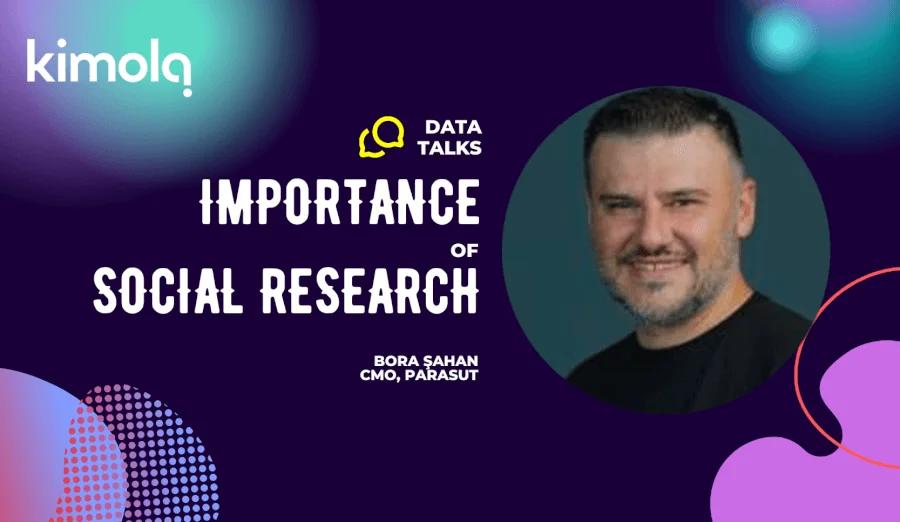Dataholic Talks #1: Bora Sahan from Parasut on Understanding Your Audience

As the company which uses
social media data
for
consumer insights
, we love talking to our clients to help them support marketing community. Today, we are here to discuss the benefits of
social listening
and social research with
Bora who has worked with Kimola to get to know their target audience better while he was working as the CMO of Paraşüt. Check out his great guidance on understanding your consumers, and sign up for Kimola for free to reveal consumer insights with
social listening
.

Interview with Bora Şahan
Mr Bora, welcome! First of all, we would like to hear about your career.
Of course… I graduated from Boğaziçi University, Department of Political Science & International Relations, in 1997. Then, I had the opportunity to work in the marketing departments of many international and local companies. After working in the marketing team of L'Oréal, I worked at Eczacıbaşı Beiersdorf. Then, I started working at Gillette as Deputy Regional Business Unit Manager, responsible for the Braun brand. I took part in brand operations in Turkey, the Balkans and Israel markets for three years. Afterwards, I worked as one of the global brand managers in Braun's "Female Hair Removal" business at the headquarters in Germany for three and a half years. After returning from there, I had the opportunity to manage and gain experience in different sectors, this time in various sizes. As a person who wholeheartedly believes that each sector experience adds a different perspective and adds a new layer to my knowledge, I took advantage of this when I was presented with the opportunity to work in the pharmaceutical industry in Sanofi after LG and Ülker. Then my path crossed with Paraşüt, and I took an active role in the growth and sales processes of the company as the Marketing Director of Paraşüt for four and a half years. I left there recently, and now I continue as the Deputy General Manager responsible for marketing another startup, AloTech and Call Center Studio.
Very nice! I understand that you have worked on the B2C side a lot, and now you are working on a more B2B side.
Exactly! I had the chance to manage marketing activities for very different sectors and very different customer types on both sides.
B2B or B2C?
So, is it more difficult for a marketer to work B2B or B2C?
Of course, both sides have their own difficulties… I always believe that marketing, no matter what you market or sell, is "the same" in certain fundamentals. The basis of this approach is the "consumer".
The critical point here is to know your customer and your target audience. I think that marketing is a business unit that combines two elements: On the one hand, you have your customer and her needs, and on the other, your product and its offerings. When you manage this process correctly, the only difficulty you may encounter is understanding your target audience's needs most accurately and including them in your brand discourse. As a matter of fact, this is the same level of difficulty for both B2B and B2C.
When it comes to B2B, We need to understand some groups that we do not come across, such as buyers in enterprise-level companies and accountants. What difficulties did you experience, especially on the B2B side? For example, when you were at Paraşüt, your target audience, the accountants, was a much more niche audience. How did you collect data here? What kind of data should you have collected? Can you share some of your experiences with us?
The biggest mistake a marketer can make is not to make profiling that accurately defines the target audience but to proceed on assumptions based entirely on himself.
I'm a marketer who believes in making data-driven decisions, whether I'm doing B2B or B2C. In B2C – leaving very niche products aside – you need to reach large audiences, monitor how subgroups (or segments) of these audiences behave towards your product category and shape your marketing activities accordingly.
When we are talking about B2B, the audience is getting smaller. Although it may seem like a good thing, it is definitely not. It becomes more challenging to capture the small audience from within the immense universe (the potential customer community you want to reach) and to have information about that audience. So actually, the answer to your question is yes; Data is more difficult to access on the B2B side. You are trying to reach a company or people representing a company and take time from them, but those people also have their own plans. That's why it's harder to talk to them.
Another issue is that after reaching the data on the B2B side, it must be an audience representing the audience you aim to target for the data to be statistically significant. So, just reaching the five people you're targeting might give you a qualitative idea, but it gets harder to see when you need larger audiences to understand general trends and approaches.
About Knowing Your Target Audience
Shall we unpack "know the target audience" a bit? If we had a magic wand today and didn't know accountants, what would we want to know about this target audience?
This depends on what you plan to offer to the target audience you have identified. If you want to keep the pulse of this target audience and develop products, you need to learn the daily routines of that audience while learning about certain attitudes and approaches. Therefore, in addition to demographic information such as "who is that person", "how old is he", "What are the solutions this person needs or what are the problems that this person is looking for a solution to?" It is also necessary to access data such as but at this point; we came across this question: "Is the problem that one person conveys a problem faced by the general public?" In this case, if you are doing conventional research, you need to enlarge the sample and measure how many people in this sample have expressed similar problems.
About Knowing Your Target Audience
I would also like to talk about your social research experiences as a marketing professional who has experienced conventional research methods. What advantages has digital data had for you?
We used social research to analyze two different audiences: "Financial Advisors" and "SMEs engaged in e-commerce". We have tried to reach both audiences with conventional research methods before. Still, when you take people from their natural environment and put them in the test environment, it isn't easy to get the information you need even if you are talking in his office.
I think the most significant benefit of social research emerges here; In an environment where you are not present, you enter the environment where you cannot usually enter, where they write about their problems and needs regarding you or the problem you are trying to solve. Without any technology, you can't analyze tens of thousands of consumers' conversations simultaneously. Thanks to social research, you have the opportunity to access, filter and make sense of all of them collectively. I think this is the most serious value of social research.
There were similar situations in the two populations we studied. We could not reach the financial advisors; even if we did, we could not get the data we wanted to get; they refrained from speaking directly of their concerns in any face-to-face conversation during conventional research. It was also essential for us to know the sources they followed or the people they were influenced by. Again, we could not discover these in one-on-one conversations because they forgot or did not want to share. Thanks to social research, we could easily reach such information by finding the target audience's behaviour on social media and the people they follow. By learning about the people, institutions and channels they interact with, we gained valuable information about the alternative channels we could reach them.
On the e-commerce side, it was also challenging to get to the audience, especially those dealing with e-commerce. Because making sure that these people fit the criteria you wanted was a time-consuming effort, we had questions about how productive it would be. Again, thanks to social research, you can go into the environments where these people are and listen to them and learn about their problems and needs in their natural habitat; We had the opportunity to observe the questions they asked each other and the help they received from each other. Doing this was a "WOW!" moment for us. For example, YouTube was a significant channel for e-commerce users. After learning that YouTube is an important channel, we planned to find out who they follow and collaborate with the people there. So social research has also opened up a new marketing channel for us.
At what stages does a marketer who does social research collect this data? For example, choosing the suitable medium, activation, and activity... I am aware that I am asking something endless. On the other hand, I do not think it is very different from conventional research. That's why I'm wondering your opinion on this.
I can easily say this: Every marketer can use this kind of data for any field in marketing.
But of course, my preference is to use this data in communication. Because you can learn the wishes, needs and problems that come out of the mouths of people one-on-one and present them to a broader audience. Especially on the B2B side, content is essential. In line with the information we have obtained here, we have made webinars on the topics that our target audience needs, wrote blog posts, and made live broadcasts and question-answer broadcasts. These activations received great attention; We had webinars with very high participation, articles read in very high numbers and projects that received many clicks. So, what does this data do in the first place?It positions your brand as a solution partner. In other words, you offer solutions that no one has been able to give them before; you answer questions. Especially in the B2B world, I see its lack; It allows you to settle into the position of a brand that meets emotional needs. One of the biggest mistakes brands make in B2B is to talk only about the product or only about the features. The information we have gained from here has given us the ability to be a brand that provides more benefits and provides solutions and answers to most questions. It was imperative and robust data for us in this context.
Suggestions
So true! I'm more impressed with what we're doing right now (Laughs). Let me finally ask this: How do you think a brand should give the brief to get the best results from the social research?
So we need to define who we are trying to reach as well as possible. I think this is the most crucial part. If you define "30-40 years old, business owner" and try to reach SMEs, you will not receive any productive and significant information in return for this definition. You won't be able to access enough private, detailed information. You might be thinking, "But how can I give more details on someone I don't already have data on?" On this subject, I guess you will have some hypotheses if you are selling products or interacting with a specific target audience. You can reach this data very easily by walking through these hypotheses. In other words, the more you detail the audience you want to reach, the more you can guarantee the accuracy of the data you have acquired. This generally creates two results:
First, you will be able to answer whether the audience you are trying to reach exists and whether this audience is a sufficiently specific group.
Secondly, you will do this experiment more quickly and practically than conventional research, and you will be able to turn the findings into action. That's why the data you have can only be "I want to reach all SMEs in Turkey", but you can say "SMEs in a specific location", and you can say "SMEs that only do food business".
You can start with such detail and give a brief. In this case, social research can tell you whether a group talks about such a topic or shares its ideas. Likewise, it can also notify you of the existence of another audience talking about similar topics.










